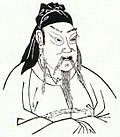 | Fuji (Chinese: 扶乩/扶箕; pinyin: fújī; Wade–Giles: fu chi), also colloquially known as "Chinese Ouija", is a method of "planchette writing", or "spirit writing"... 8 KB (792 words) - 03:35, 14 May 2024 |
 | compounds tong 童 "child; youth; boy servant" and ji 乩 "to divine" (cf. fuji 扶乩 "divination; planchette writing"). Regional variants include Hokkien tâng-ki... 4 KB (337 words) - 03:20, 19 August 2023 |
 | by mediums through spirit writing, later called Fuji (planchette writing) (扶乩/扶箕), since the late 17th century. "By the mid-Qianlong period (1736–96) the... 81 KB (11,572 words) - 16:48, 6 May 2024 |
 | the result of the ideomotor phenomenon. Spirit writing, later called Fuji (扶乩/扶箕), has a long tradition in China, where messages from various deities and... 32 KB (3,458 words) - 11:36, 29 April 2024 |




